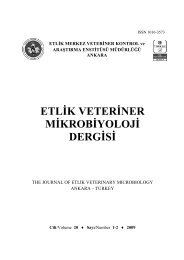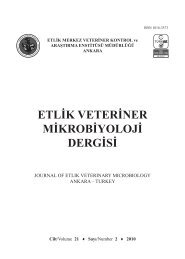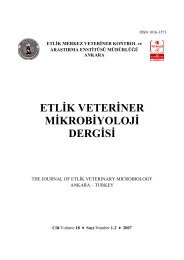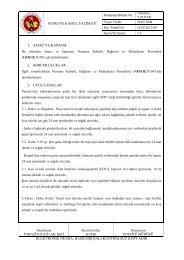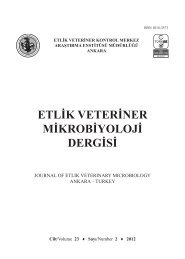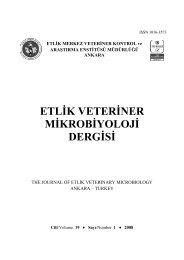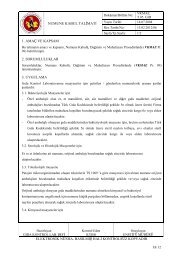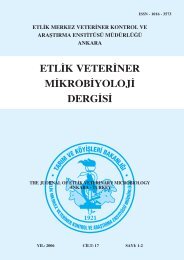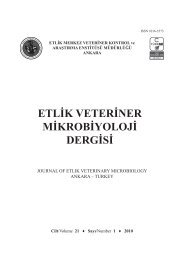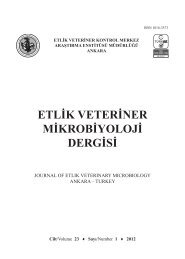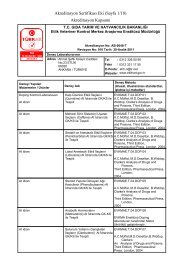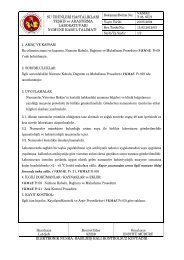etlik veteriner mikrobiyoloji dergisi - veteriner kontrol merkez ...
etlik veteriner mikrobiyoloji dergisi - veteriner kontrol merkez ...
etlik veteriner mikrobiyoloji dergisi - veteriner kontrol merkez ...
You also want an ePaper? Increase the reach of your titles
YUMPU automatically turns print PDFs into web optimized ePapers that Google loves.
50<br />
Materials and Methods<br />
Albayrak ve ark. Etlik Vet Mikrobiyol Derg, 22, 49-53, 2011<br />
Sample collection and preparation: Different<br />
places visited to collect samples around Turkey<br />
(Fig. 1). A 3 mm biopsy from the wing membrane,<br />
blood and swab samples were taken from bats. A<br />
total of 55 specimens were collected from 9 different<br />
bat species but only three of them were used for<br />
in this study (Table 1). The species were Miniopter-<br />
Figure 1. The number of samples according to provinces.<br />
Table 1. Samples collecting localities, their sizes<br />
and coordinates.<br />
Province<br />
The Number of<br />
Samples<br />
Decimal Coordinates<br />
LAT. LONG.<br />
Trabzon 4 40,980000 39,770000<br />
Gümüşhane 7 40,450000 39,430000<br />
Balıkesir 17 39,650000 27,870000<br />
Ankara 8 39,950000 32,850000<br />
Kırıkkale 11 39,870000 33,620000<br />
Hatay 1 36,220000 36,150000<br />
Adana 7 37,000000 35,330000<br />
Morphological criteria for species identification:<br />
Identification of bat species is achieved by using external,<br />
cranial measurements and baculum structure<br />
(1, 2, 4, 6, 15). Morphologically, three species were<br />
identified as M.myotis, M.blythii and M.schreibersii.<br />
Y31, Y17 and Y7 code numbers were given to each<br />
species, respectively.<br />
us schreibersii, Myotis blythii and Myotis myotis.<br />
M. schreibersii (Y7) sampled from Trabzon and<br />
M.blythii (Y17) and M.myotis (Y31) sampled from<br />
Balıkesir. Fieldworks were undertaken to avoid disturbing<br />
the colonies. Biopsy of specimens was applied<br />
as described by Worthington and Barratt (28).<br />
The 3 mm holes in wings are known to knit in four<br />
or five weeks.<br />
Nucleic Acid Preparation: Total DNA was isolated<br />
from samples using the DNeasy Tissue Kit (Qiagen,<br />
Germany), following the ‘Purification of Total DNA<br />
from Animal Tissue’ protocol. Briefly, samples were<br />
lysed overnight using proteinase K after which the<br />
lysate was loaded onto a DNA Mini spin column.<br />
The DNA was then selectively bound to the column<br />
membrane by centrifugation and stored in elution<br />
buffer of kit (-20°C).<br />
Sequence amplification: Previously published<br />
primers were used (18). BarbF1 (5’-CCT CAA ATA<br />
TTT CAT CAT GAT G-3’) and BarbR2 (5’-GTC<br />
CTC CAA TTC ATG TTA GG-3’) primer pairs<br />
were used to amplify cytochrome b.<br />
Super Script III One-Step RT-PCR with Platinum<br />
Taq was used for PCR amplification (Invitrogen,<br />
USA). PCR mastermixes were prepared according<br />
to manufacturer instructions as follows:<br />
17,8 µl of HPLC H20, 25 µl of 2XBuffer, 1 µl of<br />
forward primer (Barb F1) (0.2 µM), 1 µl of reverse<br />
primer (Barb R2) (0.2 µM) and 0.20 µl of Platinum



